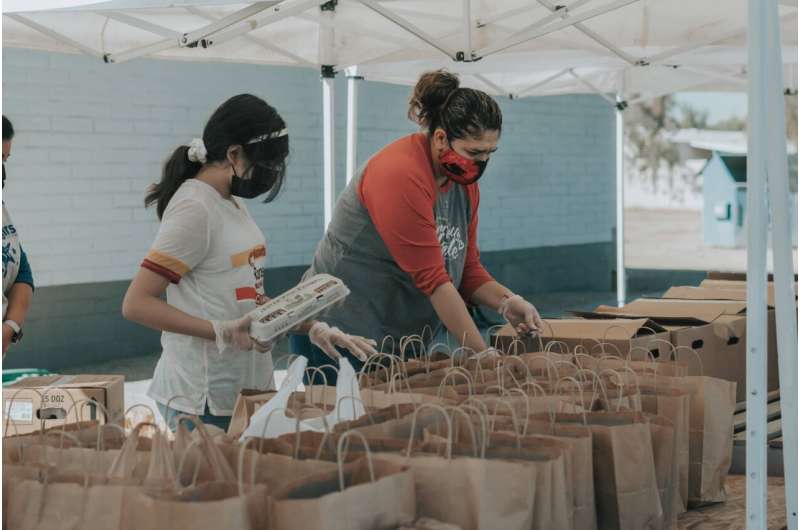Ten ways we can better respond to the pandemic in a trauma-informed way

Fear is one of the . : concerns about getting sick, the stigma of testing positive, financial difficulties due to not being able to work, separation from loved ones in lockdown (or being locked in an unsafe household). The list goes on.
For many of us, uncomfortable feelings can be "natural" responses to a "threat." Our strong, primitive defense or has enabled human beings to survive. This is essential for survival against poisonous snakes, crocodiles and other dangerous situations.
Unfortunately, our "threat responses" at recognizing the difference between the "threat" from a crocodile and a pandemic. These responses happen .
It can be particularly hard for people already experiencing or associated with to severe, repeated and inescapable threats or abuse, often from those meant to protect them.
As the pandemic hit last year, we were working on the project, which aims to improve support for Aboriginal and Torres Strait Islander parents experiencing complex trauma.
We asked ourselves whether the public health response to the pandemic can take into account people's previous trauma.
The Centers for Disease Control and Prevention in the US thought so when it integrated into in 2018.
Taking core concepts from and , we identified 10 principles that may decrease stress or trauma by fostering a sense of security, well-being, confidence, hope and resilience.
1. Safety
The first priority of any emergency or "trauma-informed response" is to ensure physical safety from the (like ). This includes the safety of people most at risk during lockdowns (for example, those experiencing ).
2. Connectedness and collaboration
Humans are and being "connected" is another essential survival strategy that is more helpful to us in the pandemic than "fighting, fleeing, or freezing."
When we have social support, it's easier to . But it's not easy staying "socially connected" yet "physical distanced" in an infectious disease outbreak.
can also lead to divisions in society, such as when one community appears to receive or an .
However, looking after each other is our ticket out of here. We have seen this with the global in the quest to create COVID-19 vaccines.
3. Compassion and caring
Acts of kindness, compassion and caring are needed more now than ever. Compassion and empathy promote well-being and we know social supports act as a .
Understanding is an important way to "normalize" our feelings, and the actions of others.
4. Trust and transparency
Clear, compassionate action and from governments are also important. These things increase a sense of safety and potential for people to follow public health advice.
Hiding information leads to distrust in government and the media. This can to mistrust in COVID-19 responses and lead to .
and exposure to misinformation can also increase distress, and leave people vulnerable to who target marginalized groups most at risk.
Rebuilding trust in an emergency may not be possible, but this is where become invaluable for communities.
5. Cultural safety and responsiveness
Public health approaches and messaging needs to be appropriate and to local contexts.
Communities need health messaging that draws on cultural strengths to increase trust and access to services, such as the way Aboriginal and Torres Strait Islander community-controlled health organizations .
6. Commitment to equity and human rights
. Many people, including Aboriginal and Torres Strait Islander and refugee communities, are affected by historical and intergenerational trauma, racism, and ongoing socio-economic deprivation.
These things can be exacerbated in this current crisis. We must address the socio-cultural determinants that can impact people's health, such as insecure work and housing, and focus on equity.
7. Good communication
say messages are most likely to be effective when they are clear, credible and interactive, shared consistently, and targeted to community groups.
The public may manage their anxiety, but can also increase their feelings of stress, confusion, and a lack of control, impacting their .
The media play a critical role here. Accessing trustworthy, reliable information through these channels is important so people know what action to take and where they can go for help.
8. Positive leadership
helps us feel safe.It's important for the government to be highly visible, provide regular updates and practical support, and help people understand and manage feelings of stress.
But we don't just need leadership from politicians and officials. also need to support their communities to , and to help people understand the crisis will pass and there is hope.
This was on show when Aboriginal and Torres Strait Islander community-controlled organizations .
9. Empowerment
comes from having choice, voice, and control. This promotes the confidence to respond to an emergency, as well as resilience, hope and the ability to cope.
Communities that are to play an active role in disaster response actually , with . However, communities must be to do this.
10. Holistic support
We need big that address health and safety, social and emotional well-being, community connectivity and cultural responsiveness to .
However, effective emergency responses must be embedded in well-functioning social systems, including emergency social and economic support and high-quality healthcare services everyone can access when needed.
Our next step will be to discuss these 10 principles with community members and public health experts in an October workshop, to develop a culturally responsive, trauma-informed, public health emergency framework for First Nations communities.
This pandemic is far from over and there is now a race to vaccinate communities that have been left behind as states open up. A trauma-informed public health emergency response is possible. And with cases due to rise just as the next bushfire and cyclone seasons arrive, we need one now.
Provided by The Conversation
This article is republished from under a Creative Commons license. Read the .![]()















